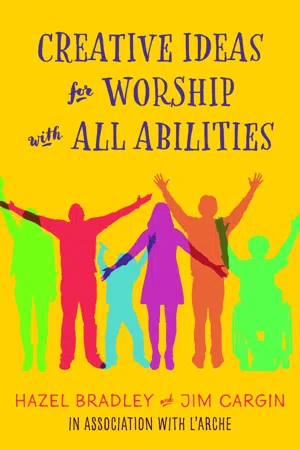![]()
PART 1
Towards an inclusive church:
How to include people with a learning
disability in the life of the church
![]()
A questionnaire on disability and inclusion
for a church leadership team
This questionnaire aims to encourage greater awareness of disability. In filling in this form, it would be helpful to consult individuals with disabilities in the church, and where needed, their friends and/or support workers. (The form may be downloaded free of charge from the Canterbury Press website: www.canterburypress.co.uk).
How does disability and learning disability fit with our theological outlook?
What difference would it make if people with learning disabilities were not here?
How can we make sure that adults with learning disabilities are fully welcomed and included in the life of our church?
Before the service?
During the service? Think about participation/language/choreography and movement
After the service?
Between Sundays?
What are the particular gifts and ministries of the individual people with learning disabilities in our church?
How can we better enable those people to exercise their gifts and ministries?
Is our welcome genuinely inclusive, or simply tokenistic?
![]()
Examples of specific ministries including
people with learning disabilities
Through baptism, a human being is recognized as a member of God’s family. The Holy Spirit pours out plentiful gifts on each, so that they can serve Christ’s mission in a way suited to their unique mix of strengths and weaknesses, be they of body, mind or spirit. In order to discover a person’s gift, it is vital to get to know them as an individual. This is as true for a person with a learning disability as it is for anyone else.
When it comes to church services, many people with learning disabilities can join in with most things that happen, and love to be given an opportunity. Each example below shows how this can work in practice. While some can accomplish their ministry independently, others may need prompting, to a greater or lesser extent. But the fact that someone needs extra support should not be considered a disadvantage. On the contrary, this gives a clear message to the congregation and visitors, that ‘we are a church where ministry is something shared by many; a church where we support each other to bring forth our gifts; and this is nothing exceptional, but part and parcel of our life in Christ’.
Here are some practical ways that people with learning disabilities can contribute to a church service: the lesson is that small allowances and discreet support can make a big difference.
Bell-ringing In some churches, a person with a learning disability is on the bell-ringing team, summoning the congregation to worship.
Welcoming Giving out service sheets and hymnbooks as people arrive. Worshippers at one church pick up their service sheets from the tray on Michael’s wheelchair. It usually takes Michael time to respond to a question, which means others need to slow down and listen carefully – not a bad preparation for the church service! At another church, Diana is proud to put on her name badge, showing she is a member of the welcoming team, a role she performs with great enthusiasm.
Serving Ralph is proud to be on the team of servers and is sometimes invited to carry the processional cross. When this happens, he is given a lighter cross, for the sake of safety – an example followed by some other team members as well. In another church, Jennifer is always paired with someone able to give her a supporting hand on the steps to the altar.
Singing and playing music Daniel, blessed with a good sense of rhythm, is much appreciated for his drum-playing in his church. Sandra, who is blind, taught herself to play the piano by ear and uses that gift in her church. Karen joined her church’s music group once someone had spotted her talent at the guitar. Tuning is something she cannot manage on her own, so another member of the group does that for her each week.
Reading Instead of breaking open God’s word in the same way each week, why not invite a group of people with and without learning disabilities to mime it now and then? This happens in some churches, and can bring new insights to a familiar Gospel passage.
Taking up the collection A long time ago, Christine’s priest took the inspired decision to invite her to take up the collection each week, a service she has now performed faithfully for many years. Now that she needs more support to fulfil this ministry, she does it in company with another person, who goes first to Christine: then one greets, while the other passes the plate. Christine takes the collection up to the altar on her own, giving it to the priest or deacon (not infrequently with a kiss!), before making a deep liturgical bow and returning smiling to her place. For many, this is a highlight of the service!
Reading the intercessions A person with learning disabilities could read a prayer, or say a prayer spontaneously, or lead a refrain such as, ‘Lord in your mercy’ or ‘Amen’. Depending on a person’s confidence and ability, they might need to do this as one of a pair.
Ministering the consecrated bread and wine at the time of communion There is no reason, why, with training and support, a person with a learning disability could not fulfil this important ministry with the required reverence and care.
What about collecting hymnbooks and service sheets at the end of the service? Sophia began doing this on her own initiative, her in-built desire for order meaning that she makes a good job of stacking the hymn books.
Helping with tea and coffee after the service Some people are exceptionally good at welcoming others, and really come into their own with a ministry like this.
These are just some of the named ministries needed during a service. Outside the service itself, churches need cleaning, the sick need visiting and raffle prizes need wrapping … the list goes on. For churches with a Parish Council, why not consider including a person with a learning disability? If one just starts by asking ‘why not?’ rather than ‘why?’ the person with a disability can be appreciated as someone called to serve the church as much as any other member, with their varied gifts and talents. Seen in this light, it is not really such a big deal if a particular person needs a little extra support. As each takes their rightful place in the body of Christ, the church will increasingly be understood as an open community for the many, rather than a closed club for the few.
![]()
Guidelines on accompanying a person with
learning disabilities to church
This could accompany the Church Belonging Form on pp. 12–14 in a person with learning disabilities’ care plan.
How to support a person with learning disabilities to attend Sunday services at their church? Here are some pointers for their caregivers. When the person is a regular, known and loved member of the congregation, you already have a head start. But help may be needed to support a person with learning disabilities to choose which church they wish to become a member of and attend. This could involve attending several churches for their Sunday worship, before deciding which one suits best, according to a range of factors including proximity, ease of access, style of worship, and most importantly, sincerity of welcome. For example, James visited a number of churches before deciding to be baptized in his local Roman Catholic Church. Many people with and without a learning disability like to attend the same church tradition as their family, but not always: Simon, for instance, preferred the lively music and worship of the Salvation Army to the more formal Anglican church of his parents. But in choosing a new church, an early step is to arrange a meeting between the disabled person and the priest or minister, who will have ideas how best to use the person’s gifts in the church.
Before setting off for church
Help the person dress well and appropriately for church: we all love to look good! These days, it is less common to wear one’s ‘Sunday best’. However, it is true that dressing smartly on a Sunday can help many people with learning disabilities to feel the specialness of going to church, and projects a more positive image.
Ensure the person has a purse with money for the collection.
As far as possible help the person to be punctual: this allows them to choose a seat they like and to have the time necessary for transition and preparation for the service. It also means there is plenty of time to go to the toilet if ne...



